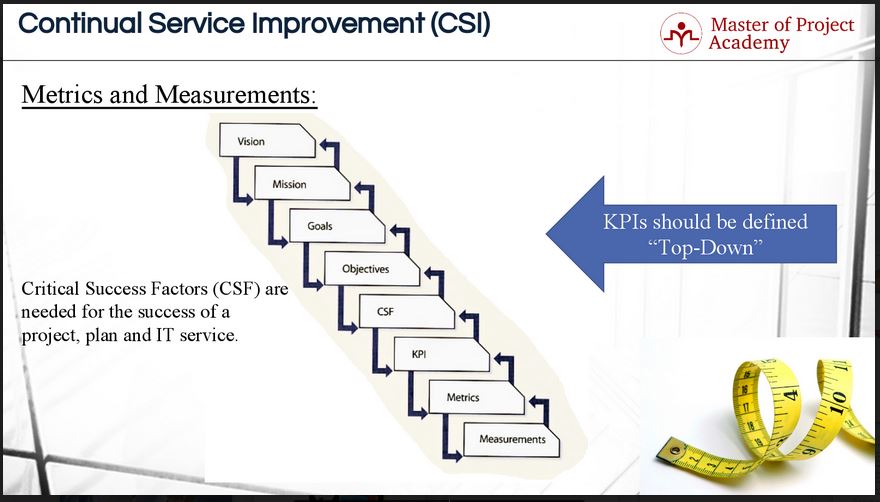Continual Service Improvement is the stage of the ITIL lifecycle that encompasses all the other stages. Throughout the service lifecycle, changes can be made to improve the performance of the service. These improvements are made based on what ITIL training material calls ITIL Key Performance Indicators or ITIL KPI for short. In ITIL Foundation certification training, it is discussed that ITIL KPI metrics are defined and aligned according to the vision of the business. Before we can improve on anything, we first need a metric to measure.

Metrics define a standard for measuring or evaluating something. And metrics serve for the quantitative assessment of a process to be measured. For instance, the percentage of the incidents resolved by the first level support can be metrics for the incident management and problem management process. The number of missed calls to the service desk due to long waiting time on the line can be metrics for the service desk function. The number of successful changes can be metrics for the ITIL change management process. And these metrics help to identify the weaknesses and strengths of the IT service provider.
ITIL Key Performance Indicators
Only the most important metrics should be defined as ITIL KPI for the processes. For instance, the most important ITIL Key Performance Indicators for the service level management process can be total SLA violations and the mean time to resolve these SLA violations. The total SLA violations ITIL KPI will measure the number of SLA violations in a given period. And the mean time to resolve SLA violations ITIL KPI will measure the average time it takes to restore SLA compliance when a violation occurs.
Similarly, the most important ITIL KPI for each process must be determined by the IT service provider.
ITIL KPI is used to measure whether the IT service provider is meeting the defined goals and objectives. It is used to identify gaps and how far the IT service provider is behind its goals and objectives are analyzed respectively.
How to define an ITIL KPI
When defining the ITIL Key Performance Indicators for processes, three fundamental points must be considered
- What does the ITIL KPI tell about goal achievements?
- How easy is an interpretation?
- What can be managed by the ITIL KPI?
This figure shows how to define ITIL KPI from top to down. The first step at the top is the vision of the company. The vision of a company describes where the company wants to be in future. And based on the vision, the mission of the company is determined. A mission describes how the company will reach its vision.

Then in the next step, short and midterm goals are determined. Goals describe the targets to reach by a company. And these targets are reached by completing the underlying objectives under a goal. For instance, the goal of an IT service provider can be to increase the availability level for a service to 99%. And one of the objectives to reach this goal can be increasing the CPU power of the servers providing this service.
Objectives are derived from the critical success factors. Critical success factors are needed for the success of a project, plan and IT service. For instance, ensuring a maximum of 10% employee turnover in the service desk of the IT service provider is a critical success factor. Similarly, ensuring a 90% customer satisfaction level can be a critical success factor as well. And these critical success factors are measured based on the defined ITIL KPI and metrics.

And in the last step, after breaking the vision down to the ITIL KPI and metrics, measurements are taken. Based on the progressive measurements, in each step of this figure, gaps, and improvement areas are identified, and further actions are revised respectively. And all these will help to reach the vision of the company as a result.
What aspects need an ITIL KPI?
Technology
Technology is component and application based. For instance, a database is an asset and the software running on a server is an asset as well. But, the technology and improvement of these two assets differ from each other. And while measuring the technology performance, availability, capacity, etc. can be the dimensions that will be measured.
Process
For the processes, the quality, performance, value, and compliance of the process are measured. And mainly, critical success factors and ITIL KPI help to measure the processes. For instance, if we consider the incident management process, a critical success factor can be to not exceed the repeated number of incidents more than five times per month. And the ITIL KPI for this can be the total number of repeated incidents per month.
Service
For the services, the end-to-end quality of the service is measured. And while measuring this end to end quality, component and application measurements are used to compute these KPI. Services, components, and regarding applications together serve a meaningful output and value for the customer. Therefore, all parts of the services are measured to find the improvement areas.
ITIL KPI is a critical term in the world of continual service improvement. Without it, IT continual service improvement teams would have a hard time knowing what areas can be improved and whether their improvement processes have even worked. Also, aligning ITIL KPIs with strategic business objectives means that only the most important critical success factors will be measured and that time will not be wasted with irrelevant measurements. In this way, ITIL KPI is the beginning and the end of the continual improvement cycle. ITIL KPI needs to be determined, measured, compared and constantly re-evaluated throughout the ITIL lifecycle.
Review by: Marilyn Castillo

One thought on “ITIL KPI: Key Performance Indicators and How to Define Them”
Comments are closed.